海洋生态系统是地球上最大、最有价值且又是最为脆弱的生态系统之一。全球海洋面积约占地球表面积的70%,体积约占生物圈的95%,是地球上最大的资源库,又称之为“蓝色海洋宝库”。由于人类活动的影响,近海生态环境的演变与退化已成为全球性的问题。例如,近年来近海赤潮的频频发生、厄尔尼诺现象等。特别是自20世纪80年代中期以来,随着我国经济发展的重心推向沿海地区,中国沿岸开始经历快速的工业化、城市化过程[1, 2]。我国沿岸海洋生态系统遭到严重破坏,尤其沿岸典型河口、海湾等均遭到不同程度的人类活动的胁迫。我国沿海地区以13%国土面积,承载了全国40%多的人口,创造了60%以上的国内生产总值(GDP),特别是近海生态系统已成为国家缓解资源环境压力的重要地带,然而经济和人口的增长对我国近海环境的胁迫作用也越来越大[3]。在此背景下,中国科学院大亚湾海洋生物综合实验站(以下简称“大亚湾站”)应运而生。1984年,位于深圳大鹏半岛东侧的大亚湾站正式建成;迄今为止已经开展了大亚湾监测、研究、示范等科研工作30余年。
1 阐明了大亚湾生态系统对环境变化的响应与适应机制依据大亚湾30余年长期生态监测与研究,提出了海洋微表层快速交换新观点,阐明了大亚湾海域低营养盐和高生产力之谜[4],提出了大亚湾生态环境动态变化模式:大亚湾海域由贫营养状态发展到中营养且局部已发现有富营养化的趋势,氮磷比(N:P)平均值由20世纪80年代的1:1.5上升到近年的>50,大亚湾营养盐限制因子已由20世纪80年代的N限制过渡到90年代后期的P限制,到近年来硅(Si)和P交替限制,打破了近十几年来一直P限制的结论,生物资源趋于小型化,生物资源衰退,揭示了大亚湾海域主要是受人类活动驱动的复合生态系统[1, 2];通过大亚湾生态系统的物理-化学-生物耦合[2, 5-7],揭示了核电站温排水对大亚湾核电站周围海域的生态环境存在一定影响,但不会影响大亚湾生态系统的变化趋势,无机氮磷比(TIN:P)是驱动大亚湾生态系统变化的关键驱动因子,解决了国际上有关核电站温排水对生态系统影响与否的长期争论[1, 2, 5-7];受中广核工程设计有限公司委托,开展岭澳核电厂三期工程核电厂与大鹏新区国家级海洋生态文明示范区相互影响研究,根据压力-状态-响应(PSR)模型计算分析可知,如增加2台机组的运行,对大亚湾海洋生态文明建设的影响仍处于6台机组运行时的水平,从而建立了核电项目对海洋生态文明影响的评价体系,为促进国家大型沿岸工业区域海洋生态文明建设提供了依据,减少了国家对核电站的双倍投入(图 1)。
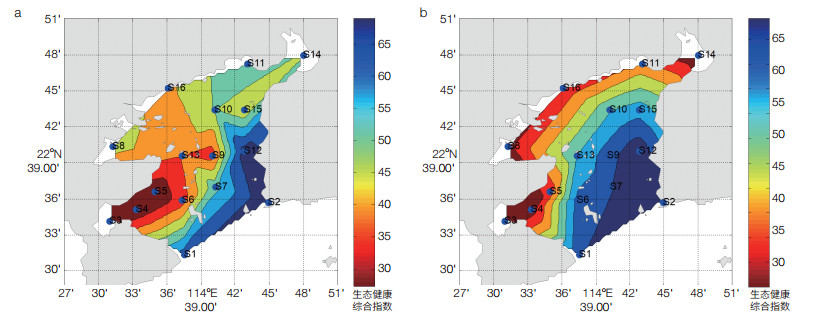
|
| 图 1 大亚湾核电项目对海洋生态文明影响的评价体系-生态健康综合指数 (a)2000年之前;(b)2018年现状 |
利用化学计量学的方法评估人类活动对大亚湾海域影响,证实了人类活动增加打破了中国近岸水体营养盐平衡这一重要发现[8],在识别人类活动与自然过程对近海生态环境变化的影响与贡献方面得到了国际上的肯定,该成果被Nature China作为亮点工作报道(图 2a),先后多次获世界能源领域权威奖项埃尼奖(Eni Award)提名;发现了大亚湾北部养殖水体影响海域占大亚湾海域1/3以上的面积,而其他海域主要是受外海水影响,首次区分了人类活动与自然变化对大亚湾海域生态环境影响与贡献。所建立的计量海洋生态学的方法与技术[5-7, 9, 10]、生态模型[8, 10]已被国际上广泛采用[11, 12],建立了计量海洋生态学的理论体系,出版了国际上首部《计量海洋生态学》专著,催生了计量海洋生态学交叉新学科(图 2b)。

|
| 图 2 论文被Nature China评述(a)和《计量海洋生态学》专著(b) |
提出并验证了“珊瑚礁高效营养生态泵”概念(图 3)[13],阐释了河口、海湾和陆架海区浮游生物功能群结构与生产过程[14];证实了痕量金属在不同食物链传递过程的显著差异性[15];揭示了海洋无脊椎动物幼虫附着变态过程和调控机制[16];开拓了柳珊瑚、笛鲷属分子辨识技术和马氏珠母贝遗传多样性研究,首次建立了3种海水鱼类的能量收支方程[17];首次摸清了华南沿岸海草种类、地理分布及其环境状况[18],建立了比较完善的海草生态系统管理体系,编制了《中国海草保护行动计划》等。研究成果充实了海洋生态系统与生物多样性研究内涵,丰富了海洋生态学理论,推动了生物海洋学发展,为海洋生物多样性保护和生物资源可持续利用提供重要科学依据。
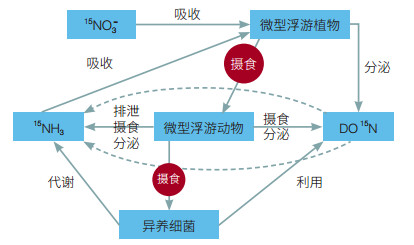
|
| 图 3 “珊瑚礁高效营养生态泵”概念图 |
首次提出“南海西部强风—上升流—藻华”形成演变的动力理论与概念模型,揭示季风与气候变化对藻华过程的调控机理,阐述南海常态藻华格局及其演变特征(图 4a)[19]。率先研究海啸等海洋灾害的生态效应,揭示台风、海啸等引发的突发性藻华过程的三维结构与生消规律;揭示了东南亚季风变动对南海浮游植物、营养盐以及碳循环影响机制[20]。系统分析南海有害藻华的时空分布特征与机理,提出相应的灾害风险评估与应急管理体系[21],在国际上出版首部有关台风研究专著Typhoon Impact and Crisis Management [22]。揭示了发生赤潮时的红色中缢虫与其体内隐藻(Teleaulax amphioxeia)的共生机制,提出了“红色中缢虫培育隐藻”的共生新模式(图 4b),成果发表在《美国科学院院刊》上[23],被评为2016年中国海洋与湖沼十大科技进展。
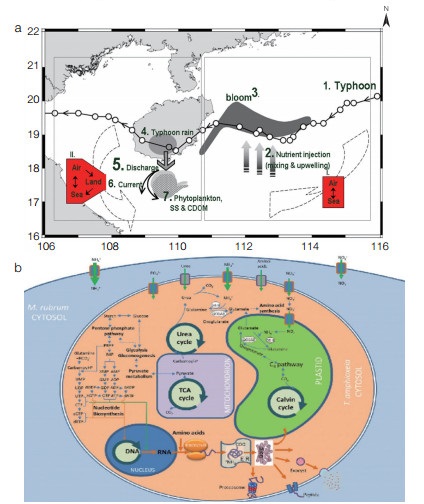
|
| 图 4 台风突发性藻华过程(a)和红色中缢虫与其体内隐藻营养物质输送机制(b) |
从红树林湿地中分离纯化得到多株高效降解菌株[24],其中A. caviae WⅡ、A. punctata TⅡ能够高效降解萘、蒽和芘,P. aeruginosa Gs降解3-甲基吲哚,生化途径为:3-甲基吲哚→吲哚-3-羧酸→3-羟基吲哚→CO2+H2O;首次阐明了Comamonas acidovorans FY1对邻苯二甲酸二酯的生物降解途径,阐明了厌氧和非厌氧条件下环境微生物参与降解特定有机污染物机理,提出了环境微生物对湿地有机污染物生物降解途径以及湿地微生物酶促还原铬(Ⅵ)脱毒反应机理等[25],为受损滨海湿地微生物生态修复提供基础科学依据。
阐明了抗氧化酶系统、植物螯合肽等在红树林抗重金属中的解毒作用,揭示了污染胁迫下红树植物抗氧化酶和脂质过氧化反应机制[26, 27],论文[26]获Elsevier出版社“中国大陆学者环境科学类杂志2005—2010年度最高引用奖”(图 5);发现了红树林Ⅱ型金属硫蛋白系统等,从生理和分子水平上揭示了抗氧化酶系统、Ⅱ型金属硫蛋白和CBF/DREB2基因等在重金属、低温等逆境条件下红树林调控机理[27-31],解决了长期困扰海洋生态学家有关红树林抗逆机理的问题,为红树林湿地植物生态修复提供了基础理论依据(图 6)。
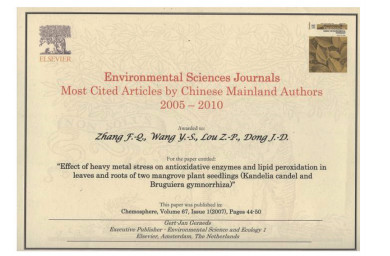
|
| 图 5 “中国大陆学者环境科学类杂志2005—2010年度最高引用奖” |
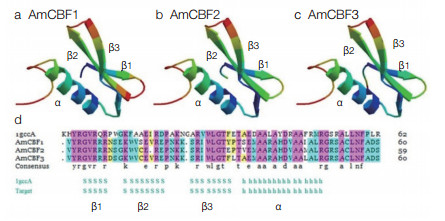
|
| 图 6 白骨壤CBF1(a),2(b)和3(c)三维结构 |
在区域发展方面,利用大亚湾站多年对核电站生态环境监测和对大亚湾生态系统影响研究成果(图 7),参与国内新建核电站(如福建漳州核电站、广西防城港核电站和广东阳江核电站等)生态监测提供服务、拟建核电站设计和选址(岭澳核电三期等)提供决策和咨询,提供了大量第一手资料和科技支撑。
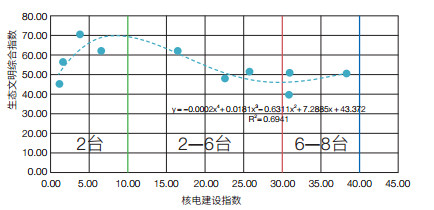
|
| 图 7 大亚湾核电项目对区域海洋生态文明的影响 |
在地方养殖业发展方面,在“海洋863”项目“珍珠贝多倍体育种”等支持下,在国内最先开展了合浦珠母贝三倍体和四倍体育种研究(图 8a),培育出三倍体群体苗4 000万个,其中三倍体最高可达70%;培育出四倍体群体2 000多个,其中四倍体占1.7%。1998—2000年在大鹏澳海滩放流中间培育的紫海胆人工苗合计约11万粒,放流1年后壳径达到4 cm左右,2年后壳径达到5 cm左右。我们在国内较早开展了华南东风螺(Babylonia lutosa)和方斑东风螺(B.arealata)的人工育苗研究,已培育出2.2万个华南东风螺稚贝,0.8万个方斑东风螺苗种投放市场。率先引进凡纳滨对虾(南美白对虾)到华南沿海(图 8b),建立了规模化全人工繁育技术,创建了对虾集约化防病养殖模式及技术体系并在养殖生产中应用,创造社会经济效益1 000多亿元,养殖产量占全国对虾产量的80%,占全世界产量的40%,使我国成为全球最大的养殖对虾生产国。“ 863”项目“军曹鱼人工繁殖及规模育苗技术研究”解决了国内军曹鱼生产性全人工繁殖与苗种培育的关键技术,从而结束了苗种完全依赖进口的历史,军曹鱼规模化养殖技术与示范已覆盖广东、广西和海南等省区,直接经济效益已超过100亿元(图 9)。依托台站先后选育出凡纳滨对虾“中科1号”和“正金阳1号”、马氏珠母贝新品“南科1号”、牡蛎“华南1号”等新品种(图 10),这些新品种推广应用将对我国海水养殖业的持续、稳定和健康发展起到极大的推动作用,丰富了海洋生物资源学和生态学理论,提高了我国海洋生物资源利用技术的研究水平,推动了我国海洋生物高技术产业跨越式发展。
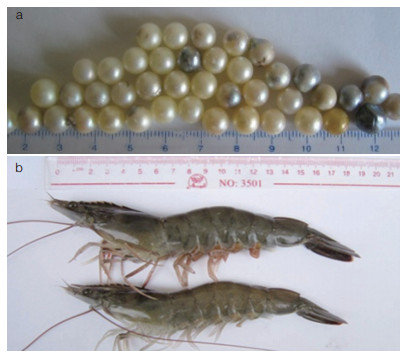
|
| 图 8 珍珠贝多倍体(a)和凡纳滨对虾(b) |
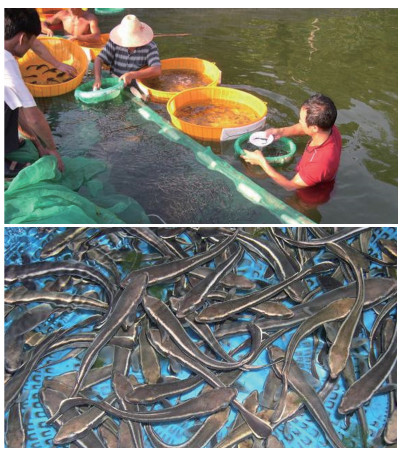
|
| 图 9 军曹鱼育苗与示范基地 |
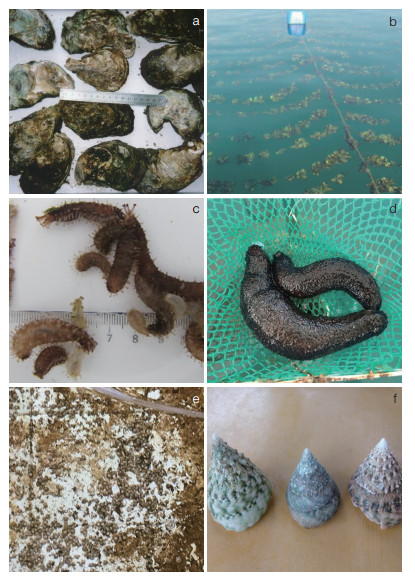
|
| 图 10 牡蛎(a, b)、海参(c, d)和马蹄螺(e, f)的人工繁殖及规模育苗 |
在区域生态保护方面,提交了8部关于海洋生态环境与保护的国家报告,建立了红树林生态系统评价与修复技术[32],为近海生态修复奠定了理论基础和技术支持。在广东湛江和南沙、浙江温州等地建立了红树林生态修复技术试验示范区15 000多亩,每年生态效益约7亿元[33],依托台站促成了与马来西亚理科大学、斯里兰卡卢胡纳大学和巴基斯坦拉斯贝拉大学等“一带一路”沿线国家的科技合作,将生态修复技术推广至马来西亚牛拉河口、巴基斯坦玛里尔河口等(图 11)。
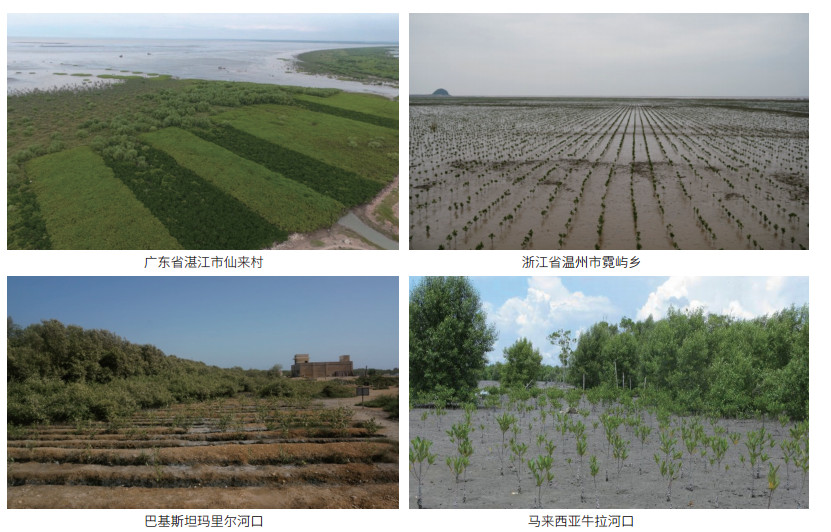
|
| 图 11 红树林生态修复示范区 |
大亚湾站自1984年建站以来,始终坚持长期生态学监测、研究、示范与服务的宗旨,面向国家海洋生态文明建设、“一带一路”建设等国家重大需求及海洋科学学科前沿,取得了一系列重要成果,为我国近海生态环境保护与生物资源可持续发展提供了重要的理论与技术支撑。近5年以大亚湾站为研究平台,先后获得国家重点研发计划项目(或国家“ 973”项目)、国家自然基金重点(面上)项目、国家科技支撑计划项目(课题)、国家“ 863”项目(课题)和各类人才项目(课题)共118项。获国家自然科学奖二等奖、省部级一等奖7项;发表研究论文370篇,其中SCI收录论文318篇;授权专利(包括软件)75项,出版专著(专刊)9部,并培养了一批海洋生态学、海洋生物学和海洋环境科学等研究的优秀人才。
独特的区位优势、完善的科学研究设施、长期历史数据的积累和丰硕的成果产出,大亚湾站已成为国内外知名的海洋科学研究基地,坚信大亚湾站未来必将成为国际一流水平的海洋生态学长期综合观测与研究平台以及生物资源可持续性研究与创新示范基地,为我国海洋生态环境保护和海洋经济可持续发展作出更大贡献,助力国家海洋生态文明建设,推动“一带一路”重大倡议建设和发展。
| [1] |
Wang Y S, Lou Z P, Sun C C, et al. Ecological environment changes in Daya Bay, China, from 1982 to 2004[J]. Marine Pollution Bulletin, 2008, 56(11): 1871-1879. DOI:10.1016/j.marpolbul.2008.07.017 |
| [2] |
王友绍. 大亚湾生态环境与生物资源[M]. 北京: 科学出版社, 2014.
|
| [3] |
戴民汉, 魏俊峰, 翟惟东. 南海碳的生物地球化学研究进展[J]. 厦门大学学报(自然科学版), 2001, 40(2): 545-551. DOI:10.3321/j.issn:0438-0479.2001.02.045 |
| [4] |
潘明祥, 张正斌, 王肇鼎, 等. 大亚湾海水微表层生物-化学研究Ⅱ(二)生物-化学特性的周日变化规律[J]. 热带海洋, 2000, 19(2): 57-63. DOI:10.3969/j.issn.1009-5470.2000.02.009 |
| [5] |
Wang Y S, Lou Z P, Sun C C, et al. Multivariate statistical analysis of water quality and phytoplankton characteristics in Daya Bay, China, from 1999 to 2002[J]. Oceanologia, 2006, 48(2): 193-211. |
| [6] |
Wang Y S, Sun C C, Lou Z P, et al. Identification of water quality and benthos characteristics in Daya Bay, China, from 2001 to 2004[J]. Oceanological and Hydrobiological Studies, 2011, 40(1): 82-95. |
| [7] |
Wang Y S, Lou Z P, Sun C C, et al. Identification of water quality and zooplankton characteristics in Daya Bay, China, from 2001 to 2004[J]. Environmental Earth Sciences, 2012, 66: 655-671. DOI:10.1007/s12665-011-1274-7 |
| [8] |
Wu M L, Wang Y S. Using chemometrics to evaluate anthropogenic effects in Daya Bay, China[J]. Estuarine, Coastal and Shelf Science, 2007, 72(4): 732-742. DOI:10.1016/j.ecss.2006.11.032 |
| [9] |
王友绍编著.计量海洋生态学-理论、方法与实践.北京: 科学出版社, 2013.
|
| [10] |
Wu M L, Wang Y S, Wang Y T, et al. Scenarios of nutrient alterations and responses of phytoplankton in a changing Daya Bay, South China Sea[J]. Journal of Marine Systems, 2017, 165: 1-12. DOI:10.1016/j.jmarsys.2016.09.004 |
| [11] |
Basatnia N, Hossein S A, Rodrigo-Comino J, et al. Assessment of temporal and spatial water quality in international Gomishan Lagoon, Iran, using multivariate analysis[J]. Environmental Monitoring and Assessment, 2018, 190(5): 314. DOI:10.1007/s10661-018-6679-2 |
| [12] |
De Carvalho C A, Moreira R M, Branco O E A, et al. Combined hydrochemical, isotopic, and multivariate statistics techniques to assess the effects of discharges from a uranium mine on water quality in neighboring streams[J]. Environmental Earth Sciences, 2017, 76(24): 830. DOI:10.1007/s12665-017-7165-9 |
| [13] |
吴成业, 张建林, 黄良民. 南沙群岛珊瑚礁潟湖及附近海区春季初级生产力[J]. 热带海洋学报, 2001, 20(3): 59-67. DOI:10.3969/j.issn.1009-5470.2001.03.010 |
| [14] |
Huang L M, Jian W J, Song X Y, et al. Species diversity and distribution for phytoplankton of the Pearl River estuary during rainy and dry seasons[J]. Marine Pollution Bulletin, 2004, 47(7-8): 588-596. |
| [15] |
Xu Y, Wang W X. Silver uptake by a marine diatom and its transfer to the coastal copepod Acartia spinicauda[J]. Environmental Toxicology and Chemistry, 2004, 23(3): 682-690. DOI:10.1897/1551-5028(2004)023<0682:SUBAMD>2.0.CO;2 |
| [16] |
Qiu J W, Qian P Y. Effects of food availability, larval source and culture method on larval development of Balanus amphitrite amphitrite Darwin:implications for experimental design[J]. Journal of Experimental Marine Biology and Ecology, 1997, 217(1): 47-61. DOI:10.1016/S0022-0981(97)00037-3 |
| [17] |
Sun L H, Chen H R, Huang L M, et al. Growth, faecal production, nitrogenous excretion and energy budget of juvenile cobia (Rachycentron canadum) relative to feed type and ration level[J]. Aquaculture, 2006, 259(1-4): 211-221. DOI:10.1016/j.aquaculture.2006.05.024 |
| [18] |
黄小平, 黄良民, 等. 中国南海海草研究[M]. 广州: 广东科学出版社, 2007.
|
| [19] |
Zheng G M, Tang D L. Offshore and nearshore chlorophyll increases induced by typhoon winds and subsequent terrestrial rainwater runoff[J]. Marine Ecology Progress Series, 2007, 333: 61-74. DOI:10.3354/meps333061 |
| [20] |
Sun Q Y, Tang D L, Legendre L, et al. Enhanced sea-air CO2 exchange influenced by a tropical depression in the South China Sea[J]. Journal of Geophysical Research, 2014, 119(10): 6792-6804. |
| [21] |
隋广军, 唐丹玲. 台风灾害评估与应急管理[M]. 北京: 科学出版社, 2015.
|
| [22] |
Tang D L, Sui G J. Typhoon Impact and Crisis Management. Berlin Heidelberg: Springer-Verlag, 2014.
|
| [23] |
Qiu D J, Huang L M, Lin S J, et al. Cryptophyte farming by symbiotic ciliate host detected in situ[J]. Proceedings of the National Academy of Sciences of the United States of America, 2016, 113(43): 12208-12213. DOI:10.1073/pnas.1612483113 |
| [24] |
Yin B, Huang L M, Gu J D. Biodegradation of 1-methylindole and 3-methylindole by mangrove sediment enrichment cultures and a pure culture of an isolated Pseudomonas aeruginosa Gs[J]. Water, Air, & Soil Pollution, 2006, 176(1-4): 185-199. |
| [25] |
Li J, Gu J D. Complete degradation of dimethyl isophthalate requires the biochemical cooperation between Klebsiella oxytoca Sc and Methylobacterium mesophilicum Sr isolated from wetland sediment[J]. Science of the Total Environment, 2007, 380: 181-187. DOI:10.1016/j.scitotenv.2006.12.033 |
| [26] |
Zhang F Q, Wang Y S, Lou Z P, et al. Effect of heavy metal stress on antioxidative enzymes and lipid peroxidation in leaves and roots of two mangrove plant seedlings (Kandelia candel and Bruguiera gymnorrhiza)[J]. Chemosphere, 2007, 67: 44-50. DOI:10.1016/j.chemosphere.2006.10.007 |
| [27] |
Huang G Y, Wang Y S. Expression analysis of type 2 metallothionein gene in mangrove species (Bruguiera gymnorrhiza) under heavy metal stress[J]. Chemosphere, 2009, 77(7): 1026-1029. DOI:10.1016/j.chemosphere.2009.07.073 |
| [28] |
Zhang F Q, Wang Y S, Sun C C, et al. A novel metallothionein gene from a mangrove plant, Kandelia candel[J]. Ecotoxicology, 2012, 21(6): 1633-1641. DOI:10.1007/s10646-012-0952-x |
| [29] |
Peng Y L, Wang Y S, Cheng H, et al. Characterization and expression analysis of three CBF/DREB1 transcriptional factor genes from mangrove Avicennia marina[J]. Aquatic Toxicology, 2013, 140-141: 68-76. DOI:10.1016/j.aquatox.2013.05.014 |
| [30] |
Wang L Y, Wang Y S, Zhang J P, et al. Molecular cloning of class Ⅲ chitinase gene from Avicennia marina and its expression analysis in response to cadmium and lead stress[J]. Ecotoxicology, 2015, 24(7-8): 1697-1704. DOI:10.1007/s10646-015-1501-1 |
| [31] |
Fei J, Wang Y S, Zhou Q, et al. Cloning and expression analysis of HSP70 gene from mangrove plant Kandelia obovata under cold stress[J]. Ecotoxicology, 2015, 24(7-8): 1677-1685. DOI:10.1007/s10646-015-1484-y |
| [32] |
王友绍. 红树林生态系统评价与修复技术[M]. 北京: 科学出版社, 2013.
|
| [33] |
Costanza R, d'Arge R, de Groot R, et al. Value of the world's ecosystem services and natural capital[J]. Nature, 1997, 387: 253-260. DOI:10.1038/387253a0 |



